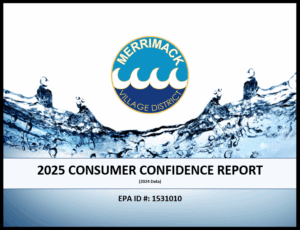MVD’s water quality and sampling is regulated by the New Hampshire Department of Environmental Services (NHDES). In order to ensure that tap water is safe to drink the United States Environmental Protection Agency (EPA) prescribes regulations which limit the amount of certain contaminants in water provided by public water systems. To comply with the required regulations, MVD tests for various contaminants, including inorganic contaminants (salts, metals), organic chemical contaminants (synthetic and volatile chemicals), and radioactive contaminants as well as some additional unregulated contaminants/chemicals. Water analyses and treatments are performed as required and directed by the EPA’s Safe Drinking Water Act (SDWA) and the NHDES Drinking Water and Groundwater Bureau (DWGB). All water tests are performed by an independent laboratory that is accredited in accordance with the National Environmental Laboratory Accreditation Program (NELAP) & the New Hampshire Environmental Laboratory Accreditation Program (NHELAP). All testing is reported to and monitored by the NHDES. Results from these tests are provided on MVD’s Annual Consumer Confidence Report (CCR). Below is the most recent CCR. Should you have any questions please contact MVD’s Business Manager, Jill Lavoie at 603-424-9241 x: 103 or by email to jlavoie@mvdwater.org
opens in a new window (Click to view)
(Click to view)
Click here to view Prior Years CCR Reports
NHDES Sanitary Survey
FAQ – QUESTIONS & ANSWERS
Below is information regarding the most common concerns/questions from MVD’s water customers.
APPEARANCE
Cloudy/”Milky”
Cloudy or “milky” water is caused by air which is harmless. As the water sits, the air will dissipate and the water will clear. The most frequent reasons of air in the water mains and/or service lines are from the following:
-
-
Outages
-
Pressure Fluctuations
-
High Usage
(ex. water main flushing or excessive seasonal usage) -
Water Main/Service Line Breaks
-
Plumbing Disturbances
(ex. repairs damage/leaks) -
Temperature – cold water holds more air than warm water.
-
Brown/Orange
Brown or orange colored water is typically from sediment, such as naturally occurring iron, that accumulates in the water mains located in the street and in the service lines connected to the water. While discolored “brown” water is not aesthetically pleasing it is not unsafe*. Sediment is normally settled in the mains and service lines, however it can be “stirred up” causing it to dislodge and subsequently discolor the water. The most frequent reasons for the water to be “stirred up” are from the following:
-
-
Outages
-
Pressure Fluctuations
-
Repairs/Construction
-
High Usage
(ex. water main flushing or excessive seasonal usage) -
Water Main/Service Line Breaks
-
Plumbing Disturbances
(ex. repairs damage/leaks)
-


